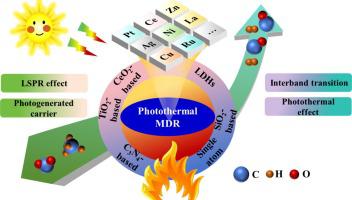当前位置:
X-MOL 学术
›
Sep. Purif. Technol.
›
论文详情
Our official English website, www.x-mol.net, welcomes your
feedback! (Note: you will need to create a separate account there.)
A review on catalyst advances for photothermal dry reforming of methane reaction
Separation and Purification Technology ( IF 8.1 ) Pub Date : 2024-07-14 , DOI: 10.1016/j.seppur.2024.128799 Xiaoyan Tian , Fagen Wang
Separation and Purification Technology ( IF 8.1 ) Pub Date : 2024-07-14 , DOI: 10.1016/j.seppur.2024.128799 Xiaoyan Tian , Fagen Wang

|
Dry reforming of methane (DRM) converts the greenhouse gases of methane and carbon dioxide to useful chemical intermediates of syngas, contributing to both environment and energy. However, the high bond energies of C–H in methane and C=O in carbon dioxide result in the endothermicity of DRM, requiring high temperature for considerable conversions of carbon dioxide and methane in conventional thermal DRM. This causes problems of carbon deposition and catalyst sintering. Recently, the photothermal DRM are demonstrated needing lower temperature than thermal DRM, significantly enhancing performance, reducing carbon deposition and minimizing sintering. These are owned to the synergistic contribution from both photo and temperature, which reduces activation energies of methane and carbon dioxide, increases surface temperature of catalyst and adjusts reaction path ways in photothermal DRM. To have an overview achievement of photothermal DRM in recent years, this paper reviews catalyst developments and mechanism investigations for photothermal DRM. We firstly introduce the active sites and principles in photothermal DRM, then the latest development of catalysts including TiO-, CeO- CN-, SiO-based catalysts, layered double hydroxide catalysts and single atom catalyst are summarized. After illustrating the reaction mechanism, the outlook of possible investigation is suggested in future. It is hoped that this paper could provide pioneers useful guidance developing catalyst for photothermal DRM, as well as other photo-sensitive reactions.
中文翻译:

甲烷光热干重整反应催化剂研究进展
甲烷干重整 (DRM) 将甲烷和二氧化碳等温室气体转化为有用的化学中间体合成气,对环境和能源都有贡献。然而,甲烷中的C-H和二氧化碳中的C=O的高键能导致DRM具有吸热性,传统热DRM中二氧化碳和甲烷的大量转化需要高温。这会导致碳沉积和催化剂烧结的问题。最近,光热 DRM 被证明需要比热 DRM 更低的温度,从而显着提高性能,减少碳沉积并最大限度地减少烧结。这些归因于光和温度的协同贡献,它降低了甲烷和二氧化碳的活化能,提高了催化剂的表面温度并调整了光热DRM中的反应路径。为了概述近年来光热DRM的研究进展,本文综述了光热DRM催化剂的发展和机理研究。我们首先介绍了光热DRM中的活性位点和原理,然后总结了催化剂的最新进展,包括TiO-、CeO-CN-、SiO基催化剂、层状双氢氧化物催化剂和单原子催化剂。在阐明反应机理后,提出了未来可能研究的前景。希望本文能够为先驱者开发光热 DRM 以及其他光敏反应的催化剂提供有用的指导。
更新日期:2024-07-14
中文翻译:

甲烷光热干重整反应催化剂研究进展
甲烷干重整 (DRM) 将甲烷和二氧化碳等温室气体转化为有用的化学中间体合成气,对环境和能源都有贡献。然而,甲烷中的C-H和二氧化碳中的C=O的高键能导致DRM具有吸热性,传统热DRM中二氧化碳和甲烷的大量转化需要高温。这会导致碳沉积和催化剂烧结的问题。最近,光热 DRM 被证明需要比热 DRM 更低的温度,从而显着提高性能,减少碳沉积并最大限度地减少烧结。这些归因于光和温度的协同贡献,它降低了甲烷和二氧化碳的活化能,提高了催化剂的表面温度并调整了光热DRM中的反应路径。为了概述近年来光热DRM的研究进展,本文综述了光热DRM催化剂的发展和机理研究。我们首先介绍了光热DRM中的活性位点和原理,然后总结了催化剂的最新进展,包括TiO-、CeO-CN-、SiO基催化剂、层状双氢氧化物催化剂和单原子催化剂。在阐明反应机理后,提出了未来可能研究的前景。希望本文能够为先驱者开发光热 DRM 以及其他光敏反应的催化剂提供有用的指导。











































 京公网安备 11010802027423号
京公网安备 11010802027423号